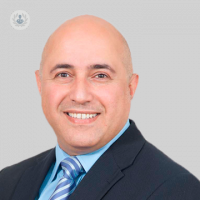Peyronie’s disease: Is my curved penis normal?
Escrito por:Some guys have a penis that curves slightly to the left or right when erect – a condition which is actually quite normal. However, if the curvature is significant and causes discomfort during sex, then it might be a sign of Peyronie’s disease and you may want to consider treatment to straighten it. Mr Aza Mohammed, a leading consultant urological surgeon explains how it develops and what treatments are available.

What's the medical name for a curved penis and how common is it?
Peyronie’s disease is the medical condition of a curved penis and is found in up to 13% of the male population. It was named after François de la Peyronie, a French surgeon who described the condition in 1743. The condition is relatively common and can develop at any age.
What causes a curved penis and how does it develop?
A curved penis is a condition caused by thickening and scarring in the outer layer of the penile cylinders, which are responsible for erections. This results in an asymmetrical expansion during erection causing curvature to one side. The exact cause is unknown but it’s suggested that it’s caused by an inflammatory response to micro-trauma sustained during intercourse. In normal circumstances, these will heal without any untoward effects but in Peyronie’s disease the inflammation is profound and causes excessive scarring.
What are the stages of Peyronie's disease?
Peyronie’s disease has two distinct stages. The first stage is the acute phase, which is characterised by painful erections and the feeling of a lump in the penis. This is the early stage and lasts for around 6-9 months. The second stage is called the stable phase which is characterised by the feeling of a distinct lump in the penis with a permanent curvature.
Are there any effective treatments for a curved penis during the early stages?
There have been different treatments suggested in the past such as vitamin E, but in reality none have been proven to be effective. More recently, penile traction therapy has been recommended to reduce the risk of profound curvature. This should be accompanied by pain killers as stretching an inflamed penis could prove to be very painful.
What are the treatment options during the later phases of it developing?
The two standard treatments available for the stable stage can be non-surgical or surgical:
- Non-surgical – this option consists mainly of having intralesional injections of Xiapex. This is an enzyme (collagenase) and is extracted from an insect called clostridium histolyticum. It acts by splitting the scar tissues of the Peyronie’s disease, resulting in softening of the tissue, which can alleviate the degree of curvature. It’s a minimally invasive procedure that can be done under local anaesthesia in an office setting. This treatment is accompanied by penile stretching exercises called remodelling. Completely straightening the penis is unlikely to be achieved but there could be a reduction in the degree of the curvature, sufficient for satisfactory penetrative intercourse.
- Surgical - the second option is surgical and there are two main modalities. The first one is called the Nesbit procedure, which involves stitching the side of the penis that doesn’t have scar tissue, and the second one is called the Leu procedure. These operations can be associated with side effects such as penile shortening and loss of penile sensation. Shockwave treatment has been tried in the past but the effect is questionable.
Patients who are considered for Xiapex need to have penile imaging done, such as an ultrasound scan, to ensure there is no extensive calcification occurring, as this wouldn’t respond well to the treatment.
When should I see a specialist?
Penile curvature that interferes with penetrative intercourse should warrant a specialist referral. There is evidence that a significant proportion of men with Peyronie’s disease suffer from depression, so treatment should be offered. The treatment itself should be carefully discussed with patients to decide the best option.
If you have a curved penis that is causing you discomfort, visit Mr Aza Mohammed’s profile and book an appointment with him online.


